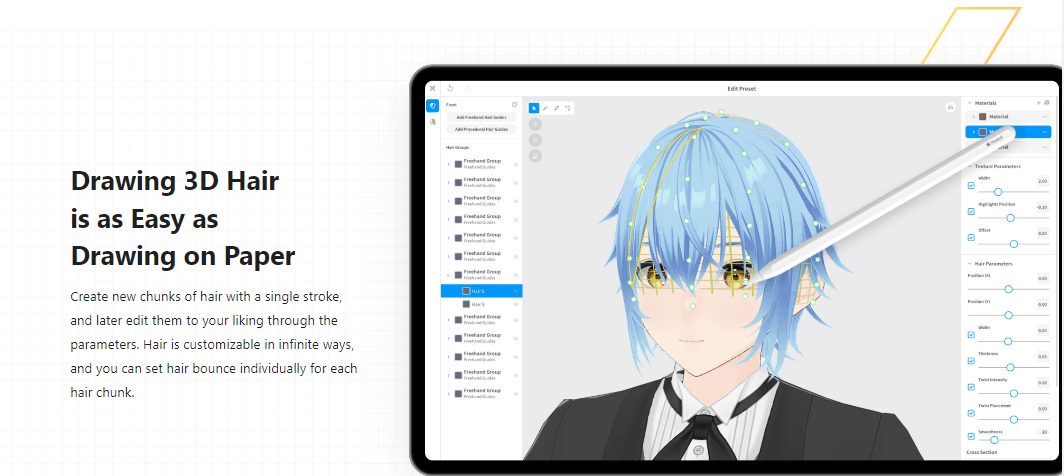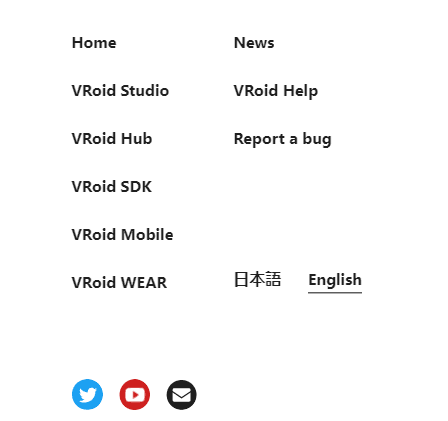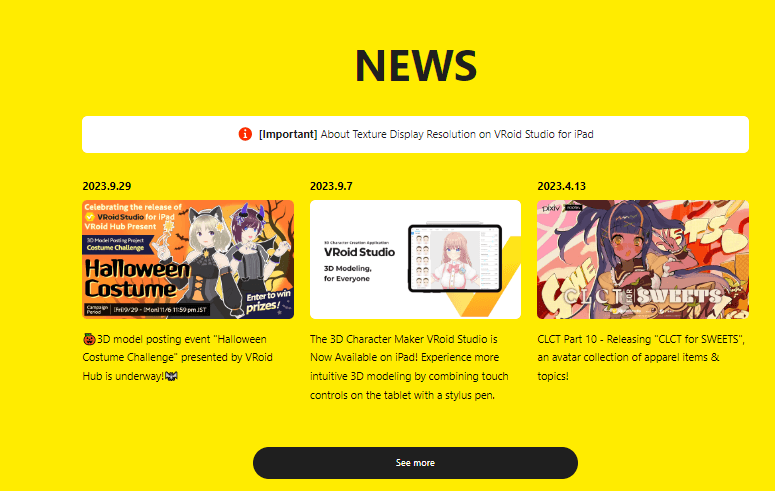I: Introduction to VRoid Studio: Unleashing Creative Possibilities
Welcome to the vibrant world of VRoid Studio, where your imagination takes centre stage and creativity knows no bounds. Developed by Pixiv, VRoid Studio is not just a tool; it’s a gateway to the exciting realm of 3D avatar creation.
A. Brief Overview of VRoid Studio
Imagine a magical tool that lets you turn your ideas into 3D characters effortlessly. Well, that’s exactly what VRoid Studio is! Created by Pixiv, it’s like a super-easy playground where anyone can create their 3D avatars. Even if you’re not a tech wizard, VRoid Studio’s simple design makes it a breeze to use.
B. Importance and Growing Popularity of Creating 3D Avatars
Have you seen those 3D avatars people use online? They’re becoming popular because they let you express yourself beyond words. With VRoid Studio, you can create unique avatars that are as individual as you are. Having a cool 3D avatar is like having your mini-me, making you stand out in the virtual crowd.
B. Overview of the User Interface and Tools
1. User-Friendly Interface:
VRoid Studio welcomes you with an intuitive interface designed for both beginners and seasoned creators. Here’s a quick tour:
- Main Menu: Access essential features like file management, editing options, and preferences.
- Toolbar: Find frequently used tools for sculpting, colouring, and refining your avatar.
- Viewport: Your canvas, where your avatar comes to life. Rotate, zoom, and pan to view your creation from every angle.
2. Essential Tools:
Now, let’s explore some of the key tools at your disposal:
- Sculpting Tools: Shape and mould your avatar with precision.
- Texture Painting: Add colour and detail to make your avatar truly unique.
- Hair Editor: Style your avatar’s hair with a variety of options.
- Pose and Animate: Bring your avatar to life with dynamic poses and animations.
II. Getting Started with VRoid Studio
A. System Requirements and Software Installation
1. System Requirements:
Before diving into the world of VRoid Studio, let’s make sure your system is ready for the adventure. Check that your computer meets the following requirements:
- Operating System: [Compatible Operating Systems]
- Processor: [Minimum Processor]
- RAM: [Minimum RAM]
- Graphics: [Recommended Graphics Card]
- 2. Software Installation:
Getting VRoid Studio up and running is a breeze! Follow these simple steps:
Step 1: [Download VRoid Studio] from the official website.
Step 2: Run the installer and follow the on-screen instructions.
Step 3: Launch VRoid Studio once the installation is complete.
Congratulations! You’re now ready to bring your creative ideas to life with VRoid Studio.
B. Overview of the User Interface and Tools
1. User-Friendly Interface:
VRoid Studio welcomes you with an intuitive interface designed for both beginners and seasoned creators. Here’s a quick tour:
- Main Menu: Access essential features like file management, editing options, and preferences.
- Toolbar: Find frequently used tools for sculpting, colouring, and refining your avatar.
- Viewport: Your canvas, where your avatar comes to life. Rotate, zoom, and pan to view your creation from every angle.
2. Essential Tools:
Now, let’s explore some of the key tools at your disposal:
- Sculpting Tools: Shape and mould your avatar with precision.
- Texture Painting: Add colour and detail to make your avatar truly unique.
- Hair Editor: Style your avatar’s hair with a variety of options.
- Pose and Animate: Bring your avatar to life with dynamic poses and animations.
With VRoid Studio’s user-friendly interface and powerful tools, creating your 3D avatar is not just a task; it’s a delightful experience. Experiment, explore, and let your imagination run wild!
III. Creating Your First 3D Avatar
A. Step-by-Step Guide to Starting a New Project
1. Launch VRoid Studio:
Begin your creative journey by opening VRoid Studio. If it’s your first time, take a moment to marvel at the possibilities that await!
2. Start a New Project:
Click on “File” in the main menu.
Select “New” to begin a fresh project.
Define your avatar’s basic settings like gender, age, and body type.
3. Shape Your Avatar:
Use the sculpting tools to shape your avatar’s body. Don’t worry about perfection at this stage; you can always refine it later.
B. Customizing Facial Features, Hair, Clothing, and Accessories
1. Facial Features:
Dive into the “Face” tab to customize eyes, nose, mouth, and more.
Adjust expressions to give your avatar personality.
2. Hair Styling:
Navigate to the “Hair” editor to choose a hairstyle.
Experiment with colours and styles until you find the perfect look.
3. Clothing and Accessories:
Explore the “Cloth” tab to dress up your avatar.
Add accessories for that extra flair.
C. Using Advanced Tools for Fine-Tuning Details
1. Texture Painting:
Head to the “Texture” tab to paint colours and patterns on your avatar.
Fine-tune details for a polished appearance.
2. Pose and Animate:
Click on “Pose” to give your avatar a dynamic stance.
Experiment with animations to bring your creation to life.
3. Lighting and Camera Effects:
Enhance your avatar’s visual appeal with the “Light” tab.
Experiment with different camera angles for stunning renders.
Congratulations! You’ve just crafted your first 3D avatar with VRoid Studio. Save your project, and feel free to revisit and make adjustments whenever inspiration strikes. The possibilities are endless, so enjoy the journey of bringing your unique character to life in the virtual realm!
IV. Mastering the Art of Avatar Design
A. Understanding the Nuances of Facial Expressions and Gestures
1. Dive into Expression Editing:
Explore VRoid Studio’s advanced features for facial expression customization.
Experiment with subtle changes to convey a wide range of emotions.
2. Gesture Magic:
Unleash the power of gestures in the “Pose” section.
Master the art of body language to add depth and personality to your avatar.
B. Tips for Creating Unique and Visually Appealing Avatars
1. Embrace Uniqueness:
Break free from the ordinary; let your imagination guide you.
Use a combination of facial features, hairstyles, and accessories to create avatars that stand out.
2. Balance Proportions:
Maintain a harmonious balance in your avatar’s features.
Avoid extremes to ensure a visually pleasing result.
3. Story in Style:
Infuse elements of storytelling into your avatar’s design.
Consider the background, occupation, or personality traits to tailor the look accordingly.
C. Incorporating Textures, Colors, and Effects for Realism
1. Texture Mastery:
Experiment with different textures for skin, clothing, and accessories.
Fine-tune details to achieve a realistic and polished appearance.
2. Color Psychology:
Delve into the psychology of colours to evoke specific emotions.
Choose a colour scheme that complements your avatar’s personality.
3. Lighting and Effects:
Play with lighting options in the “Light” tab for dynamic effects.
Experiment with shadows and highlights to add depth and realism.
Congratulations, Avatar Artist! By understanding the subtleties of expressions, embracing uniqueness, and mastering the use of textures and effects, you’re well on your way to creating visually stunning and emotionally resonant avatars.
V. Animation and Poses in VRoid Studio
A. Exploring Animation Options Within VRoid Studio
1. Animated Adventures Begin:
Navigate to the “Pose” tab in VRoid Studio to unlock a world of animation possibilities.
Discover pre-set animations or create custom ones to breathe life into your avatars.
2. Dynamic Facial Expressions:
Experiment with facial animations to convey emotions.
From smiles to winks, add a touch of dynamism to your avatar’s personality.
B. How to Create and Apply Poses to Your Avatars
1. Posing Made Easy:
Access the “Pose” tab and explore the variety of pre-set poses available.
Customize poses or create your own for a personalized touch.
2. Dynamic Scenes:
Combine poses to create dynamic scenes for a storytelling element.
Adjust angles and perspectives to enhance the dramatic effect.
3. Animation Timeline:
Delve into the animation timeline to fine-tune the timing and transitions of your poses.
Perfect your avatar’s movements for a seamless and captivating animation.
C. Adding Dynamic Elements to Enhance Your Creations
1. Props and Accessories:
Spice up your animations by adding props and accessories.
Experiment with different items to elevate the narrative of your scene.
2. Hair and Clothing Movement:
Utilize the “Hair” and “Cloth” tabs to add movement to your avatar’s hair and clothing.
Create a more lifelike and dynamic appearance.
3. Particle Effects:
Explore the “Effect” tab for particle effects that add flair to your animations.
Whether it’s sparkles or floating petals, make your avatar truly magical.
Congratulations, Animation Maestro! With VRoid Studio’s animation and pose features, you’re not just designing avatars; you’re crafting captivating stories.
VI. Optimizing and Exporting Avatars
A. Ensuring Proper Optimization for Different Platforms and Purposes
1. Size Matters:
Consider the platform where your avatar will be used.
Adjust the resolution and file size accordingly for optimal performance.
2. Platform-Specific Adjustments:
Tailor your avatar’s settings for social media, gaming, or other platforms.
Ensure compatibility and a seamless experience across diverse environments.
B. Exporting Avatars for Use in Various Applications or Platforms
1. Export Options:
Navigate to the “File” menu and select “Export.”
Explore the various export options based on your intended use (e.g., VRM, FBX, PNG).
2. Choosing the Right Format:
Consider the specific requirements of the application or platform.
Select the format that ensures the best compatibility and quality.
3. Testing Compatibility:
Before finalizing, import your exported avatar into the intended platform for a compatibility check.
Ensure that animations, textures, and details are preserved as intended.
C. Tips for Maintaining Quality During Export
1. Texture and Detail Preservation:
Pay attention to texture settings during export to maintain visual details.
Opt for high-quality settings to ensure a crisp and clear appearance.
2. Rigging and Animation Integrity:
Check that rigging and animations transfer seamlessly during export.
Resolve any issues related to joints or movement before finalizing.
3. Backup Your Work:
Before exporting, always save a backup of your project.
This ensures you can revisit and make adjustments if needed without starting from scratch.
Congratulations, Export Maestro! Your avatar is now ready to shine across different platforms, thanks to your optimization prowess.
VIII. Troubleshooting and Resources
A. Common Issues and How to Troubleshoot Them
1. Avatar Distortions:
- Issue: The Avatar appears distorted or misshapen.
- Troubleshoot: Check the rigging and joints for anomalies. Adjust the weight painting if necessary.
2. Texture Problems:
- Issue: Textures not displaying correctly on your avatar.
- Troubleshoot: Ensure texture files are in the correct format. Adjust UV mapping if textures seem misaligned.
3. Exporting Woes:
- Issue: Problems exporting your avatar.
- Troubleshoot: Check file formats and settings during export. Ensure compatibility with the intended platform.
4. Animation Glitches:
- Issue: Animations not working as expected.
- Troubleshoot: Review the animation timeline for errors. Check joint movements and poses for inconsistencies.
Congratulations, VRoid Voyager! With troubleshooting know-how and a network of valuable resources, you’re equipped to overcome any challenge in your avatar creation journey. Dive into the forums, connect with the community, and let the collective knowledge propel your VRoid Studio skills to new heights!
IX. Conclusion
A. Recap of Key Points and Benefits of Using VRoid Studio
As we wrap up our exploration of VRoid Studio, let’s revisit the key points that make this tool a game-changer:
- User-Friendly Interface: VRoid Studio’s intuitive design welcomes creators of all levels, making 3D avatar design an accessible and enjoyable experience.
- Versatility in Design: From facial expressions to dynamic poses, VRoid Studio offers a versatile toolkit to bring your avatars to life, ensuring they stand out in the digital crowd.
- Animation Magic: Unleash your creativity with animations and poses, adding a dynamic flair to your avatars and crafting immersive digital stories.
- Optimization and Export: Tailor your avatars for different platforms seamlessly, ensuring your creations look stunning across social media, gaming, and other virtual landscapes.
- Troubleshooting Resources: In the face of challenges, the VRoid Studio community, official documentation, and online forums stand ready to provide support and solutions.
B. Encouragement to Explore and Unleash Creativity in Avatar Design
Now that you’ve gained insights into the wonders of VRoid Studio, it’s time to embark on your creative journey. Let your imagination run wild, experiment fearlessly, and unleash the full potential of your avatar designs. Whether you’re crafting characters for gaming, social media, or personal expression, VRoid Studio empowers you to turn your visions into vibrant, 3D realities.
FAQ section related to mastering VRoid Studio and creating 3D avatars:
1. What is VRoid Studio, and why is it ideal for creating 3D avatars?
VRoid Studio is a free software that allows users to easily design and create 3D avatars. It provides intuitive tools and features, making it perfect for both beginners and experienced creators to craft stunning and unique avatars effortlessly.
2. What are the essential features and tools available in VRoid Studio for avatar creation?
VRoid Studio offers a range of features such as customizable facial features, hair, clothing, accessories, and various editing tools for detailed adjustments. It also includes options for creating animations and poses and adding textures to enhance the avatar’s realism.
3. Can I use VRoid Studio for commercial purposes?
Yes, you can use avatars created in VRoid Studio for commercial purposes as long as you adhere to the software’s usage guidelines and licensing agreements.
4. Are there any specific system requirements to run VRoid Studio?
VRoid Studio runs on both Windows and macOS platforms. As for the system requirements, it’s recommended to have a reasonably modern computer with sufficient RAM and a decent graphics card for smooth operation.
5. How can I export and use avatars created in VRoid Studio in other applications or platforms?
VRoid Studio allows users to export avatars in various file formats compatible with different platforms or applications. It provides guidelines and options for exporting, ensuring compatibility and quality preservation.
6. Are there any resources or communities available for further assistance and learning about VRoid Studio?
Yes, there are online communities, forums, and resources dedicated to VRoid Studio users. These platforms offer tutorials, tips, and discussions to help users enhance their skills and troubleshoot any issues they might encounter.
7. What are some tips for creating unique and visually appealing avatars using VRoid Studio?
Experimenting with various facial features, hairstyles, colours, and accessories, and paying attention to finer details like textures and expressions can help in creating truly unique and visually striking avatars. Exploring different combinations often leads to outstanding results.
8. How can I showcase my created avatars effectively?
Utilize social media platforms, personal websites, or online portfolios to showcase your avatars. High-quality images, animations, or videos displaying different aspects of your avatars can attract attention and engagement.
9. Is there a limit to the number of avatars I can create using VRoid Studio?
There isn’t a specific limit to the number of avatars you can create using VRoid Studio. You can create as many avatars as you want based on your creativity and requirements.
10. Can I collaborate or share my VRoid Studio projects with others for joint creations?
Yes, VRoid Studio allows collaboration by sharing project files. Collaborating with others enables joint creation, sharing of ideas, and combining skills to create unique avatars collaboratively.
11. Can I import custom textures or assets into VRoid Studio for avatar customization?
Yes, VRoid Studio supports importing custom textures and assets. Users can upload their textures, clothing designs, or accessories to personalize their avatars further.
12. Does VRoid Studio provide pre-made templates or presets for quicker avatar creation?
VRoid Studio offers basic templates and presets for facial features, hairstyles, and clothing options, allowing users to start with a base and then customize as desired, expediting the creation process.
13. What kind of animations can be created within VRoid Studio?
Users can generate simple animations such as facial expressions, blinking, eye movement, and gestures directly within VRoid Studio. These animations enhance the avatar’s liveliness and expression.
14. Are there tutorials or guides within VRoid Studio for beginners?
Yes, VRoid Studio includes built-in tutorials and guides to assist beginners in understanding the software’s functionalities and guiding them through the avatar creation process.
15. Can avatars created in VRoid Studio be used in gaming platforms or virtual reality applications?
Avatars made in VRoid Studio can be exported and used in various gaming platforms, virtual reality applications, and social media platforms that support 3D models or avatars.

